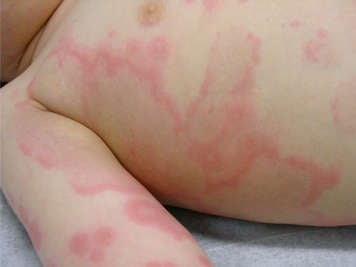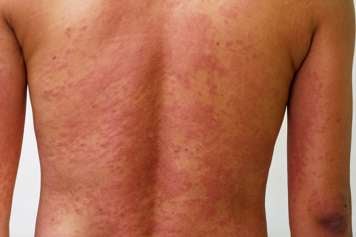What is an ampicillin or amoxicillin rash?
Ampicillin and amoxicillin are penicillin-type antibiotics. Ampicillin is given intravenously, and amoxicillin is given by mouth. They treat different types of bacterial infections and are commonly used in children.
Some children develop a skin rash while taking one of these medicines. These are ampicillin or amoxicillin rashes. They are generally divided into two groups:
- Immediate reactions: usually begin within one to two hours of taking the medication. When your child is first exposed to the medication, this may occur in the last days of treatment, but subsequent reactions will often occur after the first dose in a course.
- Delayed reactions: usually occur several hours (typically days) after exposure to the medication and may even begin days after treatment is completed. These are much more common than immediate reactions. They are less predictable and less likely to develop again with repeat exposure to the medication.
Signs and symptoms of an ampicillin or amoxicillin rash
Drug reactions have specific features and patterns.

Hives (also called urticaria)
Hives are raised, itchy, red or white swellings. They may occur in immediate OR delayed reactions (delayed urticarial eruptions). Individual spots usually go away within 24 hours, but new ones can continue to appear for several days.
Maculopapular rash (also called morbilliform)

This is a rash on the skin made up of small, flat red circles and little red bumps. It usually involves most of the chest, stomach, back, arms and legs, and may involve the face. It may be itchy and often occurs as part of a delayed reaction days after starting the medicine.
The rash tends to spread to other areas over several days. This is the most common ampicillin or amoxicillin rash. Since this type of rash is also commonly seen in children with viral infections, the rash itself does not always mean that a child has had a reaction to the antibiotic.
Causes of an ampicillin or amoxicillin rash
There are different explanations for the immediate and delayed skin rashes that develop when taking ampicillin or amoxicillin. While both types of reactions are due to the medications, they are caused by different pathways within the immune system with important differences:
- Immediate reactions: sometimes referred to as 'true allergy'. They result from activation of proteins (IgE antibodies) that the body makes against the medication and can lead to serious anaphylactic reactions. These reactions are more likely to occur when receiving intravenous (IV) ampicillin.
- Delayed reactions: often referred to as 'delayed hypersensitivity' reactions. This results from the activation of immune cells (T-cells) not involved in the anaphylaxis pathway. If a child has a viral infection when they take the medication, this can change the immune response to antibiotics and make this type of reaction more likely, though health-care experts do not fully understand why.
Risk factors for developing an ampicillin or amoxicillin rash
Risk factors related to the medication:
- how the medication is given (intravenous (IV) ampicillin has a higher degree of risk than oral amoxicillin)
- longer length of treatment
- repeated exposure to the medication
- having a viral infection while taking the medication (for example, ~90% of patients with mononucleosis (mono) develop a rash after starting ampicillin or amoxicillin)
Treatment of an ampicillin or amoxicillin rash
Both types of rash usually go away once your child stops taking the medicine. Hives usually disappear within hours. A maculopapular rash may take one to two weeks to go away and may get worse for a few days once the medication is stopped before it starts improving.
General treatment recommendations include:
- stopping the medication
- giving oral antihistamines (e.g., cetirizine) for itch
- using topical steroids (e.g., hydrocortisone cream) to help with itch and redness
- taking pictures of the rash to show your health-care provider
- talking to your health-care provider about continuing or changing the medication
Prevention after an ampicillin or amoxicillin rash
Tell your child's health-care provider if they have ever had allergic reactions to or rashes from any medicines. Describe in detail how it affected your child. For example, did your child develop:
- hives or a maculopapular rash
- itchiness
- breathing difficulty
- facial swelling
Ampicillin and amoxicillin skin rashes are diagnosed based on history and a physical exam. However, the longer it has been since a child has had a reaction, the more difficult it is for the child or their caregiver to remember the details. Providing pictures of the rash can be very helpful.
Simple maculopapular rash
If your child's health-care provider believes the reaction was a delayed-onset maculopapular rash with no signs of immediate allergy or anaphylaxis or severe skin findings, then it is reasonable to consider treatment with the same or other penicillin-type medication in the future. These reactions are not life threatening, do not indicate a true allergy, and do not indicate the medication should be avoided in the future. Many of these reactions are because of a medication–virus interaction at the time of exposure and do not develop again. When re-exposing the child, the first dose is often given in a medical setting so that your child can be monitored.
Referral to an allergist
If your child’s past reaction involved hives or any symptoms of anaphylaxis, they should be referred to an allergy specialist for evaluation before using penicillin-like drugs in the future. If there is any doubt about the nature of the previous reaction, your health-care provider can also refer to an allergy specialist to exclude immediate allergy.
Evaluation by an allergist is important for many reasons:
- There are significant health and financial costs to an inaccurate allergy.
- Penicillin-type antibiotics are some of the best treatments for several common childhood infections. A child who has been labelled as allergic to amoxicillin, but does not have a true immediate allergy, will not be prescribed first line medicines that they would be able to have.
- More than 90% of children labelled as allergic to amoxicillin based on a history of rash are not found to be allergic when tested.
- Penicillin allergies often resolve over time. Re-evaluation is suggested even in those with confirmed penicillin allergy, especially if the reaction was more than five to 10 years ago.
Other antibiotics
If your child is waiting for allergy testing or if they have a confirmed ampicillin/amoxicillin allergy, ask your health-care provider about what other antibiotics are safe to use.
Complications of an ampicillin or amoxicillin rash
Anaphylaxis
Hives that occur as an immediate reaction may be part of a more serious type of allergic reaction called anaphylaxis. However, hives can also occur in delayed reactions (delayed urticaria), and it can often be difficult for children and their caregivers to determine whether it is an immediate, serious reaction or a delayed reaction. Seek medical attention immediately if your child has hives with any of the following symptoms:
Severe skin reactions
Some serious forms of delayed reactions can begin with a maculopapular rash and then progress to more severe signs and symptoms. Seek medical attention if your child develops any of the following:
- fever (>38°C or 100.4°F) *
- involvement of mucous membranes (mouth, nostrils, eyelids, genital area)
- skin tenderness or pain
- blistering (bubbles in the skin filled with liquid)
*Although fever may be present with an underlying infection, a worrisome fever in this case is one that begins after the infection has begun to improve and happens at the same time as the new skin reaction.
Intolerance
In addition to the rash, some children may suffer from other side effects while on ampicillin or amoxicillin. These side effects may include:
- belly aches or pain
- heartburn
- nausea
- vomiting
- diarrhea
Children who experience these side effects are considered intolerant, but not allergic. Children who are intolerant can safely take the medication again without fear of an allergic reaction. Your pharmacist may be able to offer advice to help minimize these symptoms.
When to seek medical help
After taking ampicillin or amoxicillin, make an appointment with your child's regular health-care provider if your child:
- develops a skin rash (immediate or delayed). They may be referred to an allergist.
- develops symptoms of intolerance (see above)
- does not improve or develops symptoms such as persistent fever, diarrhea, red eyes or irritability
In cases of serious reactions:
- If your child has hives and other symptoms of anaphylaxis, call 911 or go to the nearest Emergency Department.
- If your child has a rash and symptoms of a severe skin reaction, seek medical attention right away.
| Symptoms of anaphylaxis | Symptoms of severe delayed reaction |
|---|---|
|
|
*Fever that begins after the infection has begun to improve and occurs with the new skin findings